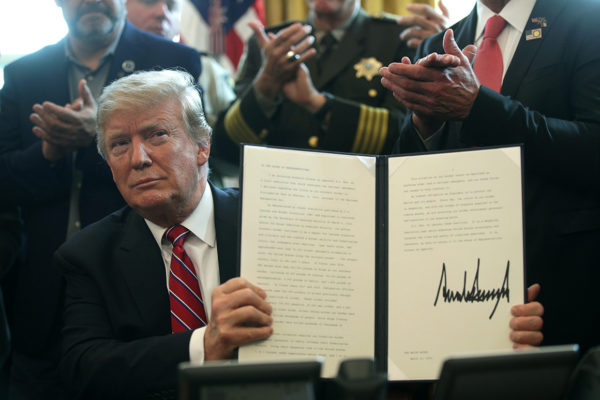 President Donald Trump vetoed a congressional resolution Friday that rescinded his national emergency declaration at the U.S.-Mexico border, wielding the power for the first time in his presidency to save a top priority.
President Donald Trump vetoed a congressional resolution Friday that rescinded his national emergency declaration at the U.S.-Mexico border, wielding the power for the first time in his presidency to save a top priority.
Trump’s veto came a day after a dozen Senate Republicans joined all Democrats in a rebuke of the president’s declaration of a national emergency in February to free up more than $6 billion for his long-promised wall along the Southwest border.
The president was flanked in the Oval Office by law enforcement officials and the families of people who have been the victim of crimes committed by immigrants in the country illegally. He described the resolution as “dangerous” and “reckless.”
“I am vetoing this resolution,” Trump said. “Congress has the freedom to pass this resolution and I have the duty to veto it.”
Democrats have accused Trump of manufacturing a crisis to build support for the wall, noting apprehensions of people attempting to cross into the U.S. illegally are at historic lows. Republican critics, meanwhile, said they are concerned Trump’s emergency is an attempt to make an end-run around Congress’s power of the purse.
But Trump has pointed out he ran in 2016 on the promise of building a border wall (though he also repeatedly promised Mexico would pay for it). The White House has said it believes more barriers would stem the flow migrants and also of illicit drugs. Others have argued that most illegal drugs arrive through points of entry.
Sen. Lindsey Graham, R-S.C., said he “totally” supported Trump’s veto.
“President Trump is right to declare an emergency on our southern border and he’s right on the law allowing him to reallocate funds to secure our southern border,” Graham wrote.
Democrats criticized the move.
“The House and Senate resoundingly rejected the president’s lawless power grab, yet the president has chosen to continue to defy the Constitution, the Congress and the will of the American people,” said House Speaker Nancy Pelosi.
Pelosi said the House would hold a vote to attempt to override the veto on March 26. Although there was bipartisan support to block Trump’s emergency, the opposition fell short of the two-thirds majority that would be required to override a presidential veto.
Democrats have promised to bring the issue back to the House and Senate floors in six months – which they are entitled to do under law – forcing Republicans to vote on the issue again.
The border emergency is the latest flash point in a new era divided government in Washington after Democrats claimed control of the House in last year’s midterm election. President Barack Obama issued his first veto after less than a year in office to block a spending bill that became redundant when Congress passed a full-year measure the same day.
President George W. Bush did not issue a single veto during his first term. When Democrats took control of Congress in 2007, Bush issued 142 veto threats and made good on 11 of them. Obama and Bush issued a dozen vetoes each.
Trump’s decision to issue the veto was not a surprise: The White House formally threatened to do so before the resolution cleared the House. Shortly after the Senate vote on Thursday, Trump posted an unusually short note on Twitter.
“VETO!” was all it read.
Trump also answered a question from reporters in the Oval Office about whether he saw a rise in “white nationalism” in the United States.
“I don’t really,” Trump said, “I think it’s a small group of people.”
Leave a Reply
You must be logged in to post a comment.